Thermoresponsive double network cryogels from dendronized copolymers showing tunable encapsulation and release of proteins†
Abstract
A series of double-network cryogels (DNCs) were prepared from oligoethylene glycol (OEG)-based dendronized copolymers as the first network and polyvinyl alcohol (PVA) as the second network. The dendronized copolymers were composed of dendritic OEG units, as well as triethoxysilyl, amine or carboxyl groups. The dendritic OEGs ensured characteristic thermoresponsiveness and triethoxysilyl groups were for crosslinking, while amino and carboxyl groups were designed to provide charged species for specifically interacting with proteins. PVA behaves as a mutual support which ensures the stability and mechanical properties of the cryogels. These DNCs exhibited good thermoresponsiveness and biocompatibility. Upon increasing the temperature above their cloud points (Tcps), the cryogels became dehydrated with enhanced hydrophobicity, and thus their porous structures shrank. This property was utilized to mediate encapsulation and release of proteins. The loading and release efficiencies of different proteins were found to be dominated by hydrophilic to hydrophobic transitions of the first network, and at the same time, by the properties of proteins. At room temperature, the cryogel could efficiently capture model proteins, while above Tcps, more than 80% of lysozyme could be released in 24 h with enzyme activity remaining unchanged. These series of smart cryogels based on thermoresponsive dendronized copolymers may provide promising applications for the reversible capture of enzymes or proteins.

- This article is part of the themed collection: 2018 Journal of Materials Chemistry B HOT Papers


 Please wait while we load your content...
Please wait while we load your content...